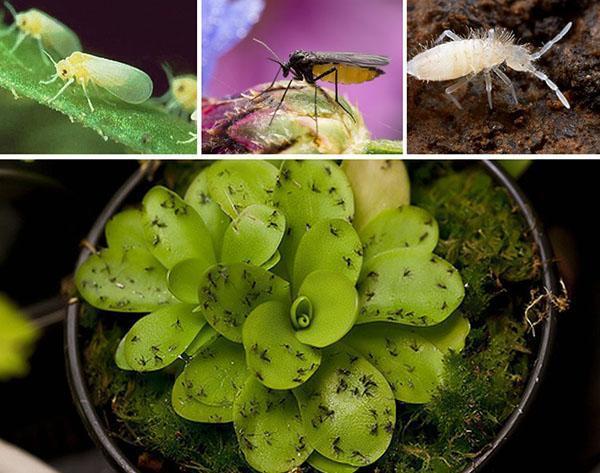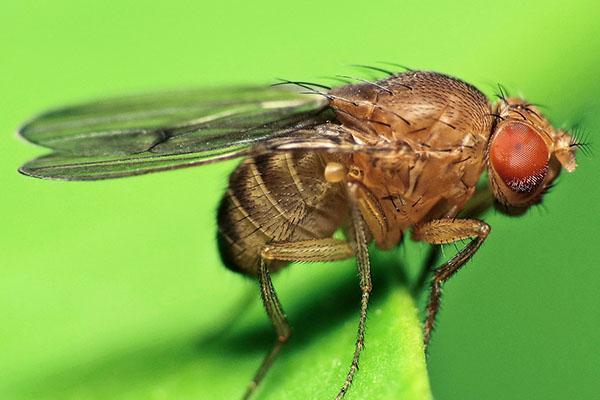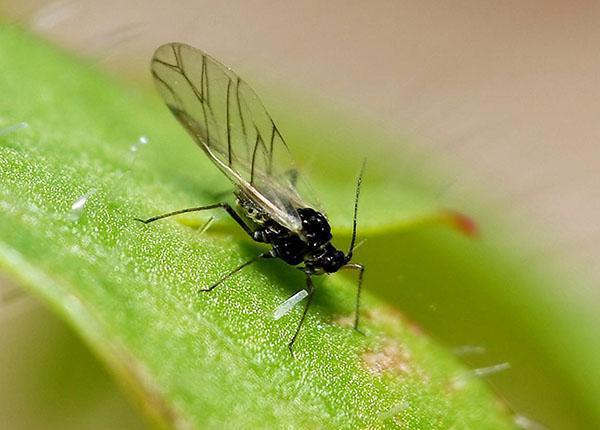Choosing proven remedies to get rid of a fly in a flower pot
 Even an attentive and experienced grower can develop flies on indoor plants in flower pots. How to get rid of uninvited insects without waiting for their spread to all plants, and what measures to take to prevent re-infection - these issues should be resolved quickly and competently. And then the home flower garden will again delight with strong healthy shoots.
Even an attentive and experienced grower can develop flies on indoor plants in flower pots. How to get rid of uninvited insects without waiting for their spread to all plants, and what measures to take to prevent re-infection - these issues should be resolved quickly and competently. And then the home flower garden will again delight with strong healthy shoots.
What flies can get in flower pots
With garden soil, a huge number of different pests can get into flower pots. But most often, three types of insects start to breed in them:
- fruit flies - fruit or fruit flies, similar in appearance to small flies;

- sciarids - the so-called mushroom gnats;
- whitefly - they look like very small butterflies with two white wings.
Drosophila in nature are ubiquitous, feed on plant sap, decaying plant debris. Fruit flies are characterized by a short life cycle and extraordinary fertility.
 Sciarids are relatively little studied and include up to 20,000 species. The most famous are mushroom, cucumber, potato, greenhouse. In this biological species, adults do not feed, and the larvae eat fungal mycelium, the roots of higher plants, and decomposing plant tissues.
Sciarids are relatively little studied and include up to 20,000 species. The most famous are mushroom, cucumber, potato, greenhouse. In this biological species, adults do not feed, and the larvae eat fungal mycelium, the roots of higher plants, and decomposing plant tissues.
 Whiteflies, or aleurodids, live on the underside of leaves and feed on plant sap. Some of their species are dangerous quarantine pests.
Whiteflies, or aleurodids, live on the underside of leaves and feed on plant sap. Some of their species are dangerous quarantine pests.
How midges end up in flower pots
 These midges can get started in a pot in different ways:
These midges can get started in a pot in different ways:
- to be in purchased or garden land that has been poorly disinfected;
- fly through an open window in summer and lay eggs in the damp ground of a flowerpot;
- get along with vegetables or fruits and multiply, and then migrate into flowers.
Excessive soil moisture contributes to the fastest reproduction of midges in flower pots. In warm and humid conditions, the larvae quickly hatch from the laid eggs and begin to actively feed. Soon it becomes noticeable by the unhealthy appearance of a houseplant - it withers, the leaves wither and fall, despite abundant watering.
In the initial stage, the infection of the plant is difficult to determine. You should carefully examine it - the topsoil and the underside of the leaves.
If insects are seen on the leaves, and there are small white larvae in the ground, urgent measures must be taken until the pests have settled everywhere.
Folk recipes for fighting a fly
 At first, you can try to get rid of midges in pots using traditional methods and start with the least traumatic for the plant.
At first, you can try to get rid of midges in pots using traditional methods and start with the least traumatic for the plant.
First, you need to let the earth dry at least two centimeters and loosen its top layer a little. In such conditions, it is difficult for the larvae to survive, since they need a moist environment. Then catch all the flying insects. This is done using glue traps.
The simplest ones are a kind of flag made of a rectangle of thick paper on a toothpick. The paper is coated with chalk or molasses and stuck into the ground among the leaves. Traps are replaced as needed. Watering the plant all this time should be very moderate so that the topsoil does not get wet. This is best done by placing the pot in a large container of water.The window sill and the surface of the ground are vacuum cleaned without a brush. It easily sucks in any flying insects.
After processing, the disposable bag must be thrown away, the usual one must be emptied outside the apartment and disinfected with dichlorvos.
After the destruction of adult midges in indoor pots, you need to tackle the land in which a large number of larvae still remain. The dried and loosened earth is watered with a solution of one of the proven folk recipes:
- Garlic infusion. One head of garlic is chopped and poured into 0.5 liters of water. The infusion is kept for several hours, then the earth is watered abundantly, the whole plant is sprayed, and the remnants of the garlic pulp are mixed with the top layer of the earth.
- Potassium permanganate solution. The plant is treated with a weak pale pink solution once a week.
- Soap solution. In one liter of warm water, dissolve 20 g of laundry soap. The resulting soapy water is watered and sprayed weekly on the diseased specimen.
- A drug for worms for pets. It is bred at a dosage suitable for treating cats and puppies and is watered weekly on the affected plant.
Folk remedies help with a low degree of infection.
 It is also convenient to remove midges from flowers in pots using a plastic bag of such volume that the entire plant will fit in it. It is important to arrange the package so that no branches are trapped. Dichlorvos is sprayed under the bag and quickly tied with a rope in the middle of the pot. In such a greenhouse, all insects die within a few hours. It is necessary to remove the bag in another room, where the flowers did not stand, and in the same place, vacuum it and place glue traps. After two weeks, the plants treated with dichlorvos are returned to their place.
It is also convenient to remove midges from flowers in pots using a plastic bag of such volume that the entire plant will fit in it. It is important to arrange the package so that no branches are trapped. Dichlorvos is sprayed under the bag and quickly tied with a rope in the middle of the pot. In such a greenhouse, all insects die within a few hours. It is necessary to remove the bag in another room, where the flowers did not stand, and in the same place, vacuum it and place glue traps. After two weeks, the plants treated with dichlorvos are returned to their place.
Fly repellent chemicals
 If folk remedies did not help to get rid of flies in a flower pot, you cannot do without the achievements of modern chemistry. Heavily contaminated soil must be completely replaced, freeing the roots from it. Then the whole plant, along with the roots, is treated with one of the special insecticides. Fitoverm is suitable for the destruction of pests,Actellic"," Bazudin ", "Aktara".
If folk remedies did not help to get rid of flies in a flower pot, you cannot do without the achievements of modern chemistry. Heavily contaminated soil must be completely replaced, freeing the roots from it. Then the whole plant, along with the roots, is treated with one of the special insecticides. Fitoverm is suitable for the destruction of pests,Actellic"," Bazudin ", "Aktara".
To prevent re-infection, only soil steamed or spilled with an insecticide should be used and the watering regime should be observed, avoiding excessive moisture in the soil in the pot.